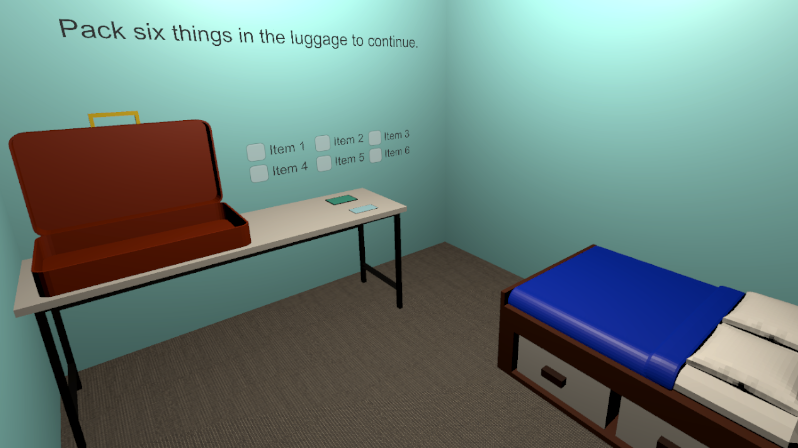Aviophoria - VR Exposure Therapy Game
Individual Project
Platform: PC (VR)
Software: Unity, Blender
Genre: Serious VR Game
Project Overview
Aviophoria is a serious VR game designed to help individuals with aviophobia (the fear of flying) through controlled exposure therapy. Created as a university project, the game aims to support patients in overcoming their anxieties related to flying by guiding them through various stages of the flying process in a safe, immersive VR environment.
Objective
The goal of Aviophoria is to help users gradually confront their fear of flying by experiencing realistic scenarios such as packing for a trip, going through airport procedures, boarding, and the flight itself. Players will complete small tasks during each stage, gradually gaining confidence in managing their anxieties in real-world flight settings.
Concept
The game focuses on immersive exposure therapy, which is proven to be effective for treating phobias. It enables users to face their fear of flying in a controlled, supportive environment where they can interact with various objects and environments (such as packing luggage and choosing seats), helping them reduce anticipatory anxiety and become more comfortable with the flying process.
Game Structure
The game is structured around levels, each representing a different stage in the flight journey. The objective of each level is to complete specific tasks, such as packing a suitcase, choosing a seat, or navigating an airport security checkpoint. Completing these tasks in the VR world helps players confront their anxieties in manageable, progressive steps. The tasks are designed to be simple at first, with increasing complexity as the player becomes more comfortable.
Level 1: Bedroom – Players begin by packing their luggage in a familiar environment. This stage addresses anticipatory anxiety, allowing the player to ease into the flying process and VR experience.
Level 2: Airport Check-In – Players proceed to interact with virtual airport environments, such as checking in and going through security. This exposes players to the anxieties related to airport logistics.
Level 3: Flight Experience – Players board a virtual plane, experiencing takeoff, turbulence, and landing. This level simulates the most anxiety-inducing parts of the flight experience, helping users become desensitized over time.
Target Audience
People who experience aviophobia, ranging from those with mild discomfort to individuals with a more intense fear of flying. The game is also suited for those who enjoy immersive experiences and exploring environments in a VR setting.
Design Approach
Gradual Exposure: Players are gently introduced to VR and the flying process, starting with simple tasks and limited movement, eventually progressing to more immersive experiences.
Therapeutic Focus: Designed to support patients outside of therapy sessions, the game helps users address specific fears like claustrophobia, acrophobia, and the fear of turbulence.
Safe Environment: The game creates a secure space with no danger, allowing users to explore without fear of harm.
Research & Development
Extensive research on aviophobia was conducted to understand the causes of fear and its manifestations (e.g., fear of loss of control, panic attacks, or the fear of turbulence). Insights from exposure therapy and cognitive behavioral techniques were integrated into the game design to ensure it is an effective tool for phobia treatment.
Therapeutic Approach:
The game utilizes VR as a tool for exposure therapy, a technique proven to help patients gradually desensitize themselves to fear-inducing stimuli. Through repeated exposure to controlled flying scenarios, players can modify their responses and reduce anxiety over time, in a way that mimics real-life therapy.
Key Features:
Immersive VR Environment: A fully interactive, realistic VR experience simulating the flying process.
Controlled Exposure: Gradual introduction to increasingly complex flying-related scenarios.
Task Completion: Players complete tasks at each stage to increase their comfort level and focus their attention on manageable goals.
Educational Elements: In-game interactions provide useful information about flight procedures, further reducing anxiety by increasing familiarity with the process.
Pains & Gains
Pains (Challenges & Fears):
Fear of Loss of Control: Players with aviophobia often feel powerless when flying, making it difficult to relax.
Fear of Panic Attacks: The anxiety of potentially having a panic attack during the flight can be overwhelming.
Fear of the Unknown: Many individuals experience anxiety over the unpredictability of flying, including turbulence, noises, and changes in altitude.
Claustrophobia: The confined space of an airplane can trigger feelings of panic for some individuals.
Anticipatory Anxiety: Worrying about flying long before the trip takes place, often leading to avoidance.
Fear of Social Stigma: Some players fear being noticed or judged for their anxiety, especially during public flight settings or at the airport.
Gains (Desired Outcomes & Success):
Overcoming Fear: Players will be able to fly with reduced anxiety and greater confidence, gaining the ability to control their fear responses.
Comfortable Travel: Overcoming the fear of flying will allow players to explore new destinations, both domestically and internationally.
Increased Control: Players will feel more in control of their environment, leading to reduced feelings of helplessness.
Improved Quality of Life: Successfully managing aviophobia allows individuals to seize career opportunities, explore new cultures, and enjoy their travels.
Self-Empowerment: Players gain a sense of achievement by overcoming their fears, boosting self-confidence and emotional resilience.


